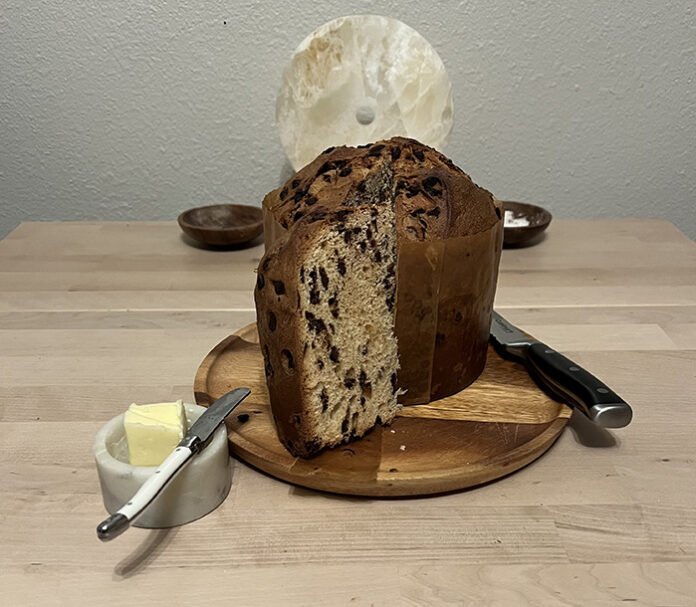Panettone is another one of Italy’s culinary gifts to the world. It’s a brioche-like cake filled with raisins and candied fruits, traditionally enjoyed over the Christmas holiday.
Italy reportedly produces 117 million panettone each year, about 10% for export. Italian production since 2005 is regulated by an authentication law, due to imitators and popularity worldwide.
Peruvians consume over 15 million panettone a year. A Brazilian bakery sells 200,000 tons of panettone annually. The Brazilian bakery, Bauducco, started by an Italian immigrant in the 1950s, advertises they pour “52 hours of love” into each cake.
It is undisputed that panettone is tricky to make and hails from Italy, more specifically Milan, but its origins are shrouded in mystery. There are so many origin stories, let’s take them in chronological order, and readers may decide.
Ancient Romans invented panettone drizzling honey on fruited bread.
Early 1400s: A cook for Ludovico Sforza (patron of Leonardo da Vinci) burnt the dessert while cooking a sumptuous Christmas meal. A kitchen helper, named Toni, rescued the meal with a sweet bread dessert made with fruits, which was so popular it became known as “Pane del Toni.”
Late 1400s: Nobleman Ughetto Degli Atellani was in love with Adalgisa, a poor baker’s daughter. Mad to marry Adalgisa, Ughetto created a sweet bread and named it after Adalgisa’s father, Toni. The bread was so popular, Ughetto won Adalgisa’s hand in marriage, and her father’s namesake bread became famous.
Late 1500s: Two days before Christmas in Pavia, just south of Milan, Borromeo College served a sweet luncheon bread to students. The recipe recorded by Bartolomeo Scappi, chef to Pope Pius V, is very similar to panettone.
Mid 1600s: A nun, named Ughetta, invented panettone to bring joy to her sisters. She made a sweet bread filled with raisins around Christmas. The word ughett means “raisin” in Milanese dialect.
Early 1800s: Giancarlo Carli wrote about a beloved monk in Milan who was fond of a Milanese sweet bread. A baker decided to make the monk’s favorite bread in the form of his domed hat, creating the signature cylindrical panettone shape.
Mid 1800s: A Milanese dictionary recorded the first written appearance of this special cake in 1839, stemming from the words panetto, meaning small loaf, and one, meaning big; hence, panettone, meaning “large loaf cake.”
Early 1900s: In 1919, Angelo Motta was baking traditional panettone when a Russian émigré escaping the Bolshevik revolution came in and ordered 200 Russian Easter cakes—kulich. He ordered them made in a cylindrical shape. Motta’s cylindrically tall cake became very popular. In 1925, Gioacchino Alemagna learned the recipe, copied Motta’s cylindrical shape, and the competition between the two fueled a national and international phenomenon.
No wonder there is a popular CNN show called Searching for Italy; Italian regional food origin stories are legion. Hat tip to Stanley Tucci.
Fun facts: By Italian law, panettone requires 20% candied fruit, 16% butter and 4% chicken egg yolks. A baked panettone must be flipped upside down within 20 seconds, or it will collapse like a soufflé.
Milanese tradition calls for saving a piece of Christmas cake to eat on Feb. 3—it’s said to bring good health, especially for the throat and respiratory system. With COVID and COVID-like flu rampant, maybe panettone will help? My Nonna thought so. Readers may decide.









